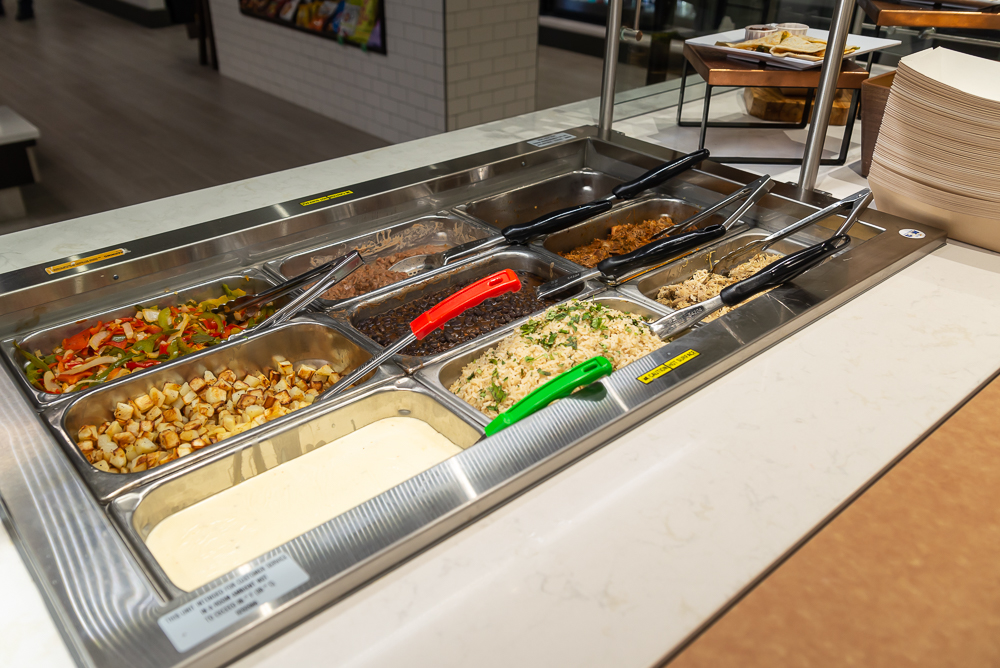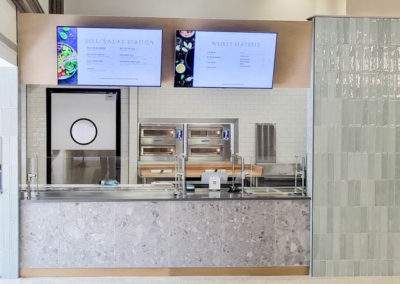Office Cafeteria Consultants
SERVING YOUR AREA
Ready to improve or build your food service operations? Contact us to talk to one of our experts right away!
or call 800-899-6604
Employee Cafeteria Design Services
Keep employees happy with a convenient and inviting on-site cafeteria. With professional office cafeteria and kitchen design from Rapids Contract, you’ll impress potential recruits and employees with streamlined food service and inviting dining spaces perfect for socializing and eating. Plus, you can save money by upgrading to energy-efficient appliances and lighting, all while creating a comfortable cafeteria for your staff.
Expert Office Kitchen and Cafeteria Design
With a well-designed, full-service kitchen and cafeteria, you can streamline the way your employees order, pay, and receive their lunch, allowing them plenty of options as well as time to enjoy their breaks and their food. A carefully designed floor plan results in a cost-effective and efficient lunch service environment with plenty of options for healthy meals as well as comfort foods. A flexible kitchen sets up a productive way to provide a variety of menu items to keep employees coming back for more.
Smaller companies that don’t need full-service cafeterias can benefit from a staff kitchen and dining area. With the sink, microwave, oven, and dishwasher all in the right places, your employees can easily prepare their own meals and clean up afterward.
Project Management for On-Site Employee Kitchens and Cafeterias
Through decades of experience, we have exemplified the importance of communication in keeping employee cafeteria projects on schedule and on budget. Our team sustains regular communication with electrical, plumbing, and construction vendors and lets you know where we are in the process of building your cafeteria and kitchen.
Equipment and Smallwares Fulfillment
Your purchase from Rapids includes everything from kitchen and cafeteria design to ordering equipment and installing it in your kitchen. We know the latest and greatest kitchen equipment for employee kitchens. We even have an online store of durable small appliances and equipment, so you can order replacements if you need them.
Get Ideas From Experts in The Industry
Track Record of Success With Major Chains
Handling Local Code Requirements
Ease your mind with our expertise in boring and complicated health and building code requirements. Rapids handles all of this, ensuring your business’ new kitchen remains in compliance and has the required documentation and specifications to ensure approval and authorization by local officials.
Good Design Saves Money
You don’t just want a kitchen and cafeteria that satisfies your employees—you want a kitchen that can help save you money. Excellent design can help you achieve those savings. Work with Rapids to create a design solution certified by the Leadership in Energy & Environmental Design Program (LEED). You’ll discover how every design decision—equipment, technology, lighting, etc.—can save on expenses and potentially qualify your company for energy-saving tax credits. Reduce energy costs and leverage energy-efficient design with environmentally conscious employees.
Frequently Asked Questions for Cafeterias
How long does it take to install an employee cafeteria?
In general, smaller and less complex kitchens in an existing foodservice space might take a few weeks to a couple of months to install, while larger and more intricate kitchens could take several months. Here are some key factors that can influence the installation timeline:
1. Design and Planning: The design phase can significantly impact the installation time. If the kitchen’s layout and design are well-prepared in advance, it can help streamline the installation process.
2. Equipment Selection and Availability: The type of equipment needed for the kitchen can affect the timeline. If specialized or custom equipment is required, it might take longer to source and install.
3. Permits and Regulations: Obtaining necessary permits and complying with local regulations can sometimes be a time-consuming process that impacts the installation timeline.
4. Construction and Infrastructure: If any modifications or construction work is required to accommodate the kitchen, such as plumbing, electrical, or ventilation systems, this can add to the installation time.
5. Skilled Labor and Contractors: Availability of skilled contractors, electricians, plumbers, and other professionals can influence how quickly the installation can be completed.
6. Project Management: Efficient project management can help keep the installation on track and avoid delays.
7. Unforeseen Issues: Unexpected challenges or issues that arise during installation, such as equipment malfunctions or structural problems, can extend the timeline.
8. Size and Complexity: Larger kitchens with more intricate setups, multiple workstations, and specialized equipment can naturally take longer to install.
9. Coordination and Scheduling: Coordinating the various tasks involved in the installation, such as equipment delivery, construction work, and inspections, requires careful scheduling.
It’s recommended to work closely with a firm like Rapids who has solutions engineers, designers, project managers, project coordinators, and support teams experienced in commercial kitchen installations. we can provide a more accurate estimate based on the specific details of your project and help manage the process to ensure it’s completed as efficiently as possible.
How much does an employee cafeteria cost?
1. Location: The cost of commercial real estate can vary greatly based on the region, city, and neighborhood where you plan to set up your kitchen.
2. Size and Layout: The overall square footage and layout of the kitchen will impact costs. A larger kitchen will require more equipment, materials, and space planning.
3. Equipment: The cost of commercial kitchen equipment varies based on the type and brand. High-quality, specialized equipment can be more expensive. Equipment includes ovens, stoves, refrigerators, freezers, fryers, grills, ventilation systems, dishwashers, and more.
4. Ventilation and Exhaust Systems: Proper ventilation and exhaust systems are crucial for a commercial kitchen to ensure air quality and safety. These systems can be a significant cost factor.
5. Utilities and Infrastructure: Costs associated with plumbing, electrical work, and gas lines installation or modifications need to be considered.
6. Construction and Renovation: If you’re building or renovating a space to accommodate the kitchen, construction costs can vary based on the extent of the work required.
7. Permits and Regulatory Compliance: Obtaining permits and complying with health and safety regulations may incur fees.
8. Interior Design and Finishes: The quality of finishes, such as flooring, countertops, and wall coverings, can impact costs.
9. Furniture and Fixtures: If you’re setting up a restaurant or eatery within the kitchen space, the cost of furniture and fixtures for the dining area should also be considered.
10. Labor Costs: Labor costs include not only the salaries of kitchen staff but also costs for installation, construction, and any specialized services needed.
11. Contingency: It’s wise to budget for unexpected costs that may arise during the setup process.
Due to the many variables involved, it’s challenging to provide an exact figure. However, to give you a rough idea, setting up a basic small-scale commercial kitchen could start around $50,000 to $100,000. Larger, more complex kitchens with high-end equipment and finishes could cost several hundred thousand dollars or even more.
To get a more accurate estimate for your specific situation, it’s recommended to consult with our commercial kitchen design and construction professionals. We can assess your needs, provide cost breakdowns, and help you plan a budget that aligns with your goals.
What layout options are available when designing an employee cafeteria?
1. Assembly Line or Linear Layout:
This layout resembles an assembly line, with different stations for each step of the food preparation process. It’s ideal for fast food chains with a limited menu of items that can be prepared quickly. The workflow progresses in a linear fashion, from order taking to food assembly.
2. U-Shaped Layout:
A U-shaped layout places the cooking equipment and prep stations along the three sides of a U shape, with the middle left open for movement. This allows cooks to access equipment and ingredients without having to cross paths frequently.
3. L-Shaped Layout:
In an L-shaped layout, the kitchen equipment and workstations are arranged along two adjacent walls in an L configuration. This can be effective for smaller spaces and helps streamline the workflow between cooking and preparation areas.
4. Island Layout:
An island layout positions equipment and stations in the center of the kitchen, allowing cooks to access equipment from all sides. It’s suitable for larger kitchens with ample space and can provide a more flexible workflow.
5. Zoned Layout:
This layout divides the kitchen into distinct zones, each dedicated to a specific task such as cooking, preparation, dishwashing, and storage. It’s efficient for larger kitchens and helps prevent congestion by keeping different tasks separate.
6. Open Kitchen Layout:
An open kitchen layout allows customers to see the food preparation process, which can add transparency and a sense of freshness. This layout requires careful organization to maintain a clean and presentable appearance.
7. Parallel Layout:
In a parallel layout, equipment and stations are placed along two parallel lines. This is useful for kitchens with a linear workflow, where tasks progress from one end to the other.
8. Zone and Flow Layout:
This layout combines zoned areas with a logical flow of food preparation. It ensures that tasks progress smoothly and avoids unnecessary backtracking.
9. Hybrid Layout:
Depending on the specific needs of your restaurant, a combination of different layouts can be used to optimize space and workflow. For example, a U-shaped layout for cooking and an assembly line for order preparation.
Remember that the layout should be tailored to your restaurant’s unique requirements, menu items, and anticipated customer flow. It’s important to consider factors like the placement of cooking equipment, prep stations, serving areas, and storage to create a seamless and efficient kitchen environment. Consulting with Rapids’ professional kitchen designers and solutions engineers can help you make informed decisions and create a layout that maximizes productivity and safety.
Where do you get your supplies from?

Previous Work – Cafe 655 at Principal
Café 655 is a breakfast/lunch hub located in The Principal’s Corp 2 building, handling more than 1,000 transactions a day. It offers 24/7 Micro Market access as well as serviced breakfast and lunch Monday through Friday.
The main goal of this project was to move the café from the third floor to the first, taking over underutilized catering, storage, and office space and making the café more accessible and attractive to employees.
Previous Work – Roshek Building
Discover the historic charm of downtown Dubuque at the iconic Roshek Building. Undergoing an extensive interior renovation, this 9-story architectural gem has been transformed into a thriving hub of office spaces for esteemed companies such as Cottingham and Butler, Heartland Financial, and more.
As part of our involvement, we had the privilege to design and outfit two vibrant cafés on the first floor, serving as convenient dining options for the building’s employees.

LET'S FIND YOUR SOLUTION
Rapids Contract & Design serves the United States with locations in Iowa, Minnesota, and Missouri. Our experts are ready to assist with your foodservice needs—contact us for support, Monday through Friday, 8 AM to 5 PM CST.
or call (800) 899-6604

















